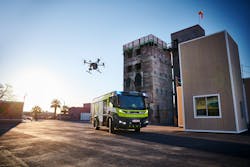NFPA Tip Sheet Highlights COVID-19 Precautions
A s emergency response personnel on the front lines are exposed to lethal pathogens or test positive for COVID-19, the NFPA released a tip sheet that highlights information within NFPA 1581: Standard on Fire Department Infection Control Program and guidance from the Centers for Disease Control and Prevention (CDC). Written for fire departments, NFPA 1581 can be translated easily to fit EMT, paramedic and law enforcement needs during this unprecedented time when PPE supplies are scarce.
The resource breaks down responder infection control into five key areas.
Infection Control Officer—NFPA 1581 states that departments should have a part- or full-time employee who serves as the infection control officer (ICO) to manage all contamination aspects from guidance on PPE to post-incident management and cleaning. Per the U.S. Department of Health and Human Services, hospitals and healthcare facilities must notify department ICOs any time that members are exposed to a known COVID-19 positive patient.
Keep Yourself, Gear Clean—NFPA 1581 clearly identifies the following times to wash hands or to use hand sanitizer (minimum of 60 percent alcohol), when hand-washing isn’t available:
- After each emergency medical incident;
- Immediately or as soon as possible after removal of gloves or other PPE;
- After cleaning and disinfecting emergency medical equipment;
- After cleaning PPE;
- After any cleaning function;
- After using the bathroom; and
- Before and after handling food or cooking and food utensils.
Use PPE—NFPA 1581 requires departments to keep infection-preventing PPE, such as gloves, eyewear and masks, onboard all department vehicles that support EMS operations. For the COVID-19 virus, responders should use droplet protection.
Limit Your Exposure—Limiting exposure can reduce the need for PPE and assist with long-term staffing availability. Some measures that can be taken to reduce exposure include, but are not limited to, the following:
- Provide emergency medical dispatch protocols that require dispatchers to request that, when safe and able, the patient awaits responders outside in the open air;
- Limit the number of members who interact with patients; and
- Once a member dons PPE, he/she should stay in the PPE for the remainder of patient-care activities.
Expand Options in Shortages—The CDC advises departments to either lower the protection levels of PPE that are being used for patient care and cleaning or to reuse the PPE, after following disinfection procedures, if supply levels run low. Here are recommendations for departments to consider until adequate levels of PPE can be acquired:
- Instead of going down a level in respiratory protection, consider going up a level, such as with a powered air purifying respirator (PAPR) that has the appropriate filter or cartridge;
- Work with your ICO, agency risk management, subject-matter experts and your medical director to develop protocols that allow for triaging the use of remaining higher-level PPE; and
- Departments should increase your buying power by leveraging contracts, mutual aid agreements and memorandums of understanding.
For more information, visit nfpa.org.
Rosenbauer Partners with Drone Expert DJI
Rosenbauer International AG and DJI, which manufactures civilian drones provides and aerial-imaging technology, entered into a strategic partnership to bring the benefits of digital emergency response management to anyone who is involved in tackling an emergency situation. Whether used by a private company at an airport or industrial facility or a local fire department that’s called to an emergency because o f severe weather, an aerial perspective combined with Rosenbauer’s operation management system enables the situation to be quickly assessed and informed decisions made regarding the safest and most efficient deployment of personnel.
“Speed and a truly complete overall picture are key criteria for success when emergency service teams have to make purposeful decisions under time pressure,” said Dieter Siegel, who is CEO of Rosenbauer International. “We have already supported their efforts to meet these criteria with our IT solutions, which range from efficient vehicle management to navigation, right through to alarm. This cooperation with DJI enables us to consolidate our role as a digital pioneer while we work together to develop an integrated technology for comprehensive, data-based firefighting and disaster management.”DJI aims to provide reliable, scalable drone offerings that empower firefighters, search and rescue and public safety teams to benefit from this technology. “It plays an increasing role in saving lives, time and resources on a daily basis,” said Jan Gasparic, who is director of strategic partnerships at DJI. “This integration is an important step for this long-term partnership, and our commitment demonstrates an increasing maturity in the adoption of drones for firefighting professionals.”
Rosenbauer’s operation management system is an information management system for firefighting operations that supports emergency crews on scene with relevant information, such as fire safety maps, hazardous material data and vehicle rescue sheets. Data from DJI’s drone fleet management software, FlightHub, will be integrated seamlessly into Rosenbauer’s operation management system, which gives additional visual and thermal data to the decision-maker of the operation. This information then can be relayed to operational units on scene on a tablet or displayed on monitors back at the command center, giving a full overview of the situation. Informed decisions can then be made in real-time regarding the efficient and safe deployment of resources, such as personnel, vehicles and other equipment.
Data safety is paramount, and all information that’s delivered to the Rosenbauer operation management system in real-time and from DJI's FlightHub, is stored on a server in a highly secure computer center of a well-known European telecommunications firm. The transfer of data is encrypted. During deployment the data also is synced with all mobile end devices, so every operational team has the same information and it’s kept in a closed loop.
For more information, visit rosenbaueramerica.com.
This Month in Fire History
May 4, 1973—National Commission on Fire Prevention and Control publishes “America Burning”
May 5, 1988, Norco, LA—Petroleum refinery fire; loss worth $513 million
May 6, 1937, Lakehurst, NJ—Hindenburg zeppelin fire kills 36
May 14, 1947, Rome, NY—Minerva Film Company fire kills 23
May 18, 1971—NFPA 19B Standard requires SCBA use during firefighting
May 23, 1964, San Francisco—All Hallows Church Parish Hall fire kills 17
May 28, 1977, Southgate, KY—Beverly Hills Supper Club fire kills 165
May 31, 2013, Houston—Southwest Inn fire kills 4 firefighters
Courtesy: NFPA
About the Author
Firehouse Staff
Content written and created by Firehouse Magazine editors.

